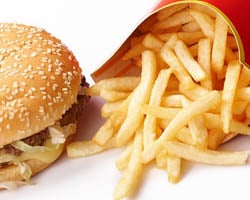
A fast-food meal may sound like a good deal, especially when you don’t have time to prepare breakfast or lunch. A comparison of cost vs. nutritional value, however, paints a very different picture.
The average cost of a combo meal at a fast food restaurant is $4 to $7. Preparing a comparable meal at home costs about the same, but the real savings are in the calories, fat, and sodium.
The ‘fast’ in fast-food means the restaurant must take shortcuts with their raw materials or prepared foods (like pre-cutting and freezing vegetables) – time-saving methods that compromise or deplete nutrients. Food prepared at home from fresh, organic ingredients, on the other hand, provides maximum nutritional value, plus the peace of mind that comes with knowing exactly what goes into your food.
Breakfast
Thirty per cent of Americans eat breakfast outside the home. That means huge profits for the fast-food breakfast industry, amounting to over $40 billion dollars a year.
Eggs, one of the best protein foods, help to regulate appetite and promote alertness. Best of all, they’re inexpensive (even free-run, organic eggs) and quick to make.
Jack in the Box’s Hearty Breakfast Bowl sates your morning hunger with scrambled eggs, hash browns, bacon and sausage crumbles topped with cheddar cheese and a white cheddar cheese sauce, all for $2.99. The 853 calories, 64 grams of fat (mostly saturated) and 1,386 mg of sodium that come with it will fill you up but will also slow you down… just in time for work. Studies consistently show that a diet high in saturated fat and calories can impair mental performance and memory, leaving us less functional at work.
Preparing a similar meal at home reduces all those values by half. A nourishing homemade breakfast of two large scrambled eggs with goat cheese and diced vegetables, turkey bacon and whole grain toast provides 453 calories, 27 grams of fat, and 653 mg of sodium, all for a cost of only $2.36 and can be whipped up in less than ten minutes.
Lunch
Lunch is the most popular fast-food meal. If you opt for a salad over a burger, however, you may be choosing a loaded lunch.
Wendy’s Southwest Taco Salad – iceberg and romaine lettuce, tomatoes, chili and cheddar cheese, has a whopping 640 calories and 38 grams of fat. That’s a lot of calories for a salad! It also comes with an unexpected 1.5 grams of trans fat and 1,570 mg of sodium. You’re better off spending the same amount of money, about $5, on a homemade chicken and chili salad. An incredibly healthy mix of greens, diced vegetables, chicken breast and vegetarian chili, even topped with a tablespoon of an oil-based dressing provides just 392 nutrient-dense calories, 15 grams of fat, and only 388 mg of sodium. As a bonus, the 13 grams of fiber fills about half of the day’s recommended quota.
If a sandwich is your preference, Arby’s $5.01 Regular Roast Beef Combo comes with curly fries and a small drink. Unfortunately, it also comes with 940 calories, 35 grams of fat, including 0.5 grams of trans fat, and 1,900 mg of sodium. Using organic roast beef, multigrain bread and replacing the fries with a bean salad saves you two-thirds of the calories and has only 9 grams of fat (zero trans fat), 644 mg of sodium and 7.5 grams of fiber – all for only $3.08!
While convenient and inexpensive fast-food meals may seem appealing in the short term, the price we pay for short-cuts, medical costs resulting from obesity, malnutrition, and inflammatory diseases (diabetes, heart disease, hypertension) is staggering. Most fast-food restaurants now provide their nutritional information on-line or in-store. Do your homework before you order, but make it a goal to prepare and eat the majority of your meals at home.










